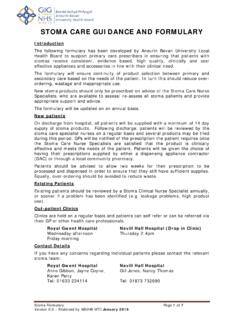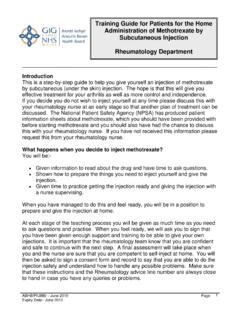Transcription of Fundamentals of Microbiology
1 Session 1 Fundamentals of MicrobiologySession overview Classification Microbial nomenclature Microbial growth Microbial death Spore formationClassificationThe Five Kingdom system is used to classify all organismsDifferentiation between organisms is based upon cellular structure (morphology) metabolism (biochemistry) reproduction DNAFive basic types of micro-organism: algae, protozoa, fungi, bacteria and virusesThe first four fall within three of the kingdoms:Fungi, Protista and MoneraViruses do not fall within the Five Kingdom schemeGram reaction (Gram positive and Gram negative) Developed in 1884 by Danish physician Christian Gram Only used for bacteria It is the first step in identifying unknown bacteria It is based upon a differential stain-Gram positive cells retain the stain and Gram negative do not The difference is due to differences in cell wall compositionMicrobial nomenclature All organisms have two names-the first signifies the genus and the second signifies the species This is a binomial system-devised by Linnaeus Genus name can be abbreviated, species name should not Campylobacter jejuni can be abbreviated to C.
2 Jejuninot Campylobacter growthGrowth is the process by which: individual cells increase in size and massand the population increases in numberBasically metabolism and reproductionReproduction for bacteria and fungi tends to be asexual-budding or fissionBuddingFission Growth on solids is in the form of colonies-visible to the naked eye Within solid foods micro-colonies will appear In liquids, growth appears as increasing turbidity Moulds grow as a filament where cells stay attached(described as hyphae), but not all the cells will grow-only those at the tip of the filamentTwo types of growth system-open and closed Within a open system nutrients are constantly replenished and population growth will not biofilms in the pipework of food factories will have constant access to fresh nutrients Within a closed system, nutrients and other factors will become limited and growth will eventually in a bottle of milk the nutrients will run outThere are four distinct growth phases for a unicellular organism in a closed, liquid cultureGrowth phases Lag phaseNo growth occurs because the cells are adapting to the new environmentLength of period varies.
3 Dependent on culture conditions Log phaseCells are growing exponentially or logarithmically-the population doubles within a certain time-depends on exact conditions, but can be as little as 20 minsThis is called the generation time Stationary phaseA nutrient depletion or toxic by-product build up stops the cells from metabolising or reproducing-the cell numbers remain static Death phaseIn this phase the cells start to die and the viable population decreasesPopulation death is also exponential-not all the cells die at onceMethods for measuring growth Colony countsaerobic colony count for all viable bacteriaselective counts for particular organisms/species Direct countsusing a microscope-viability can be determined with special stains Absorbance measurementfor clear liquid cultures onlyMicrobial deathDeath can be defined as the inability of a cell to both metabolise and reproduce due to irreversible
4 Cell damageDeath of cells leads to loss of viability-normally defined as the ability to grow and producing visible colonies on a plate or producing turbidity in liquidHowever, lack of growth is not always the same as deathSome species may enter a viable but non-culturable phase-cells do not reproduce in culture but may retain viability and if pathogenic, the ability to infectExamples are Listeria and CampylobacterThis is possibly a stress reaction and may occur in aquatic environmentsStill just a theory!Survivor curvesWhen the population (rather than the individual cell) is considered, microbial death can be given a mathematical basis and various parameters can be calculatedD values give the time taken to reduce the population by one log ( 1000 to 100)What does this mean?
5 It basically gives a measure of the resistance to factors such as heat and radiationSurvivor curveOther more complex parameters can be calculated from D values Z and F valuesWhy is this relevant?D and other values are the basis for all food processing operations-pasteurisation, sterilisation and Cans undergo a 12D cook for Clostridium botulinum- in other words the cook is aimed at reducing Cl botulinum spores by 12 logsFor example, this means a reduction from 106 to 10-6 spores per gramFor moulds, spore formation is a method of reproductionMoulds will release millions of spores, which will then move through air or liquid, and if they land on a suitable surface they will germinate and produce vegetative mould cellsIt is solely a reproductive functionSpore formationSome bacteria also produce spores-however, this is a survival mechanismBacterial spores are known more correctly as endospores.
6 Since they are produced within the cell and only released upon the death of the cellEndospores are dormant and will only germinate to produce a vegetative cell when conditions are suitable for bacterial growthBacterial spores are very resistant to heat, alkali, acid, dryness and can survive for yearsSession summary Classification and nomenclature are important to ensure consistency of identity and naming Growth is an increase in cellular mass and population Unicellular growth in closed liquid systems occurs in four phases Death curves can be used to calculate appropriate heat treatment regimes for foodstuffs Bacterial endospore formation is an important survival mechanism











